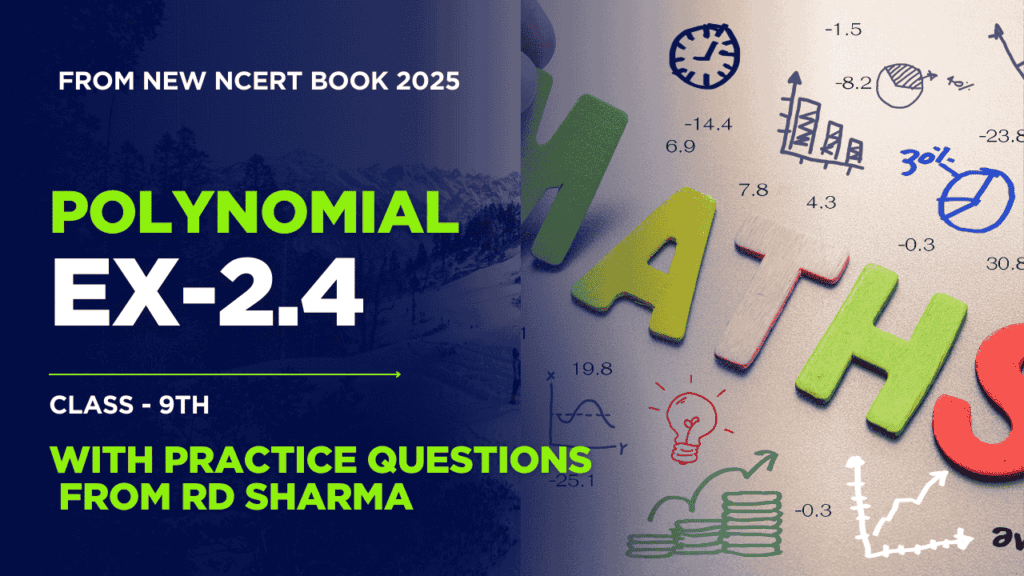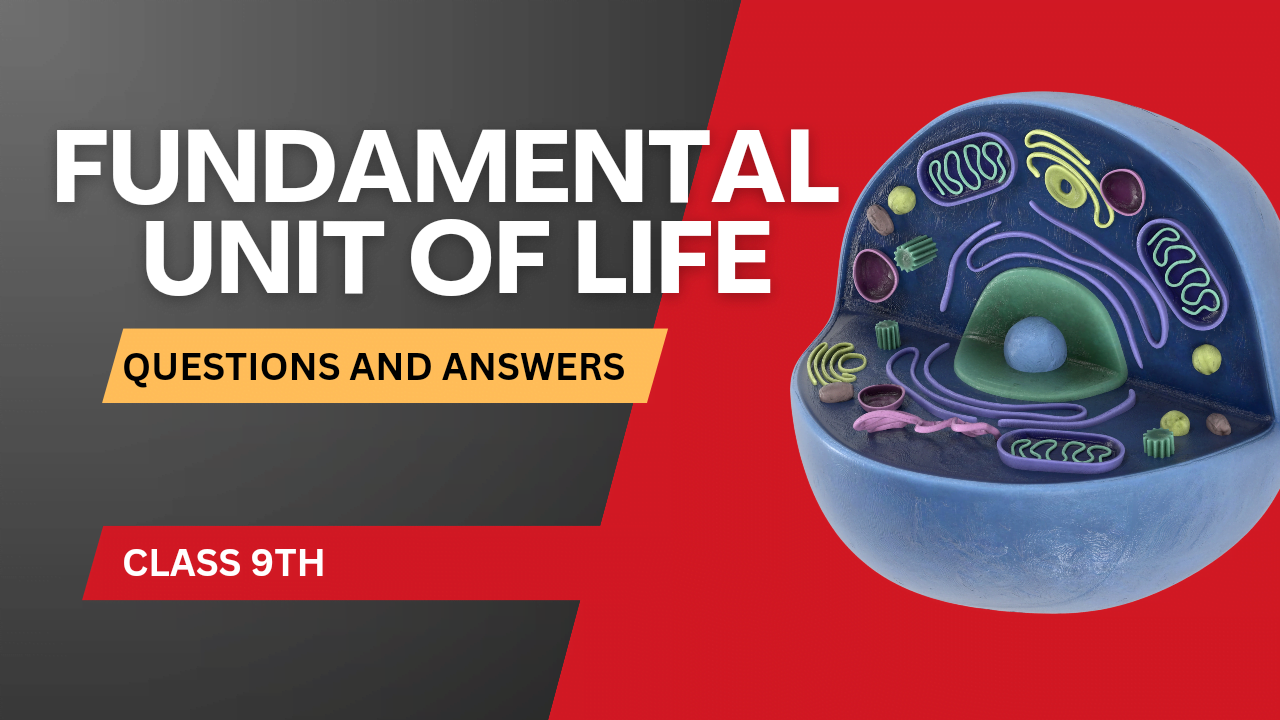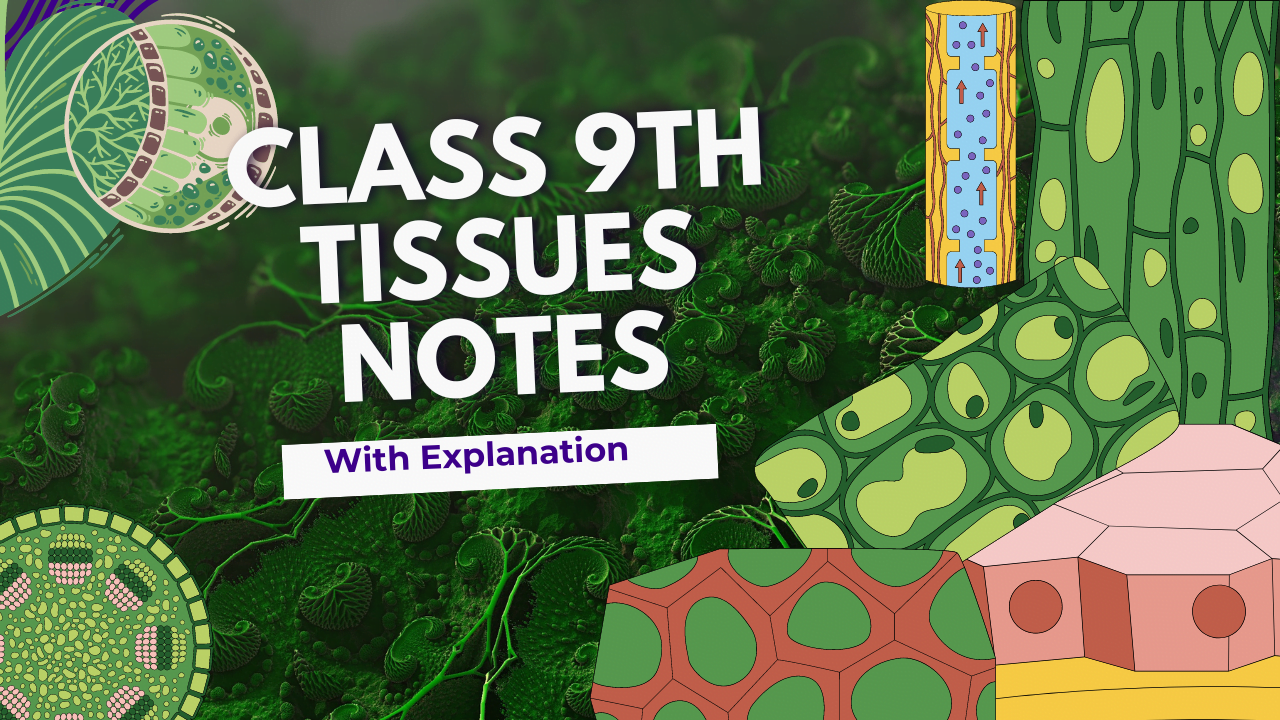
Exercise 2.4 Solutions
1. Use suitable identities to find the following products:
(i) \((x + 4)(x + 10)\)
Using the identity \((a + b)(a + c) = a^2 + a(b + c) + bc\): \[ (x + 4)(x + 10) = x^2 + x(4 + 10) + 4 \times 10 = x^2 + 14x + 40 \]
(ii) \((x + 8)(x – 10)\)
Using the identity \((a + b)(a – c) = a^2 + a(b – c) – bc\): \[ (x + 8)(x – 10) = x^2 + x(8 – 10) – 8 \times 10 = x^2 – 2x – 80 \]
(iii) \((3x + 4)(3x – 5)\)
Using the identity \((a + b)(a – c) = a^2 + a(b – c) – bc\): \[ (3x + 4)(3x – 5) = (3x)^2 + 3x(4 – 5) – 4 \times 5 = 9x^2 – 3x – 20 \]
(iv) \((y^2 + \frac{3}{2})(y^2 – \frac{3}{2})\)
Using the identity \((a + b)(a – b) = a^2 – b^2\): \[ (y^2 + \frac{3}{2})(y^2 – \frac{3}{2}) = (y^2)^2 – \left(\frac{3}{2}\right)^2 = y^4 – \frac{9}{4} \]
(v) \((3 – 2x)(3 + 2x)\)
Using the identity \((a – b)(a + b) = a^2 – b^2\): \[ (3 – 2x)(3 + 2x) = 3^2 – (2x)^2 = 9 – 4x^2 \]
2. Evaluate the following products without multiplying directly:
(i) \(103 \times 107\)
Using the identity \((a + b)(a + c) = a^2 + a(b + c) + bc\) where \(a = 100\), \(b = 3\), and \(c = 7\): \[ 103 \times 107 = (100 + 3)(100 + 7) = 100^2 + 100(3 + 7) + 3 \times 7 = 10000 + 1000 + 21 = 11021 \]
(ii) \(95 \times 96\)
Using the identity \((a – b)(a – c) = a^2 – a(b + c) + bc\) where \(a = 100\), \(b = 5\), and \(c = 4\): \[ 95 \times 96 = (100 – 5)(100 – 4) = 100^2 – 100(5 + 4) + 5 \times 4 = 10000 – 900 + 20 = 9120 \]
(iii) \(104 \times 96\)
Using the identity \((a + b)(a – b) = a^2 – b^2\) where \(a = 100\) and \(b = 4\): \[ 104 \times 96 = (100 + 4)(100 – 4) = 100^2 – 4^2 = 10000 – 16 = 9984 \]
3. Factorise the following using appropriate identities:
(i) \(9x^2 + 6xy + y^2\)
Using the identity \(a^2 + 2ab + b^2 = (a + b)^2\): \[ 9x^2 + 6xy + y^2 = (3x)^2 + 2 \times 3x \times y + y^2 = (3x + y)^2 \]
(ii) \(4y^2 – 4y + 1\)
Using the identity \(a^2 – 2ab + b^2 = (a – b)^2\): \[ 4y^2 – 4y + 1 = (2y)^2 – 2 \times 2y \times 1 + 1^2 = (2y – 1)^2 \]
(iii) \(x^2 – \frac{y^2}{100}\)
Using the identity \(a^2 – b^2 = (a – b)(a + b)\): \[ x^2 – \frac{y^2}{100} = x^2 – \left(\frac{y}{10}\right)^2 = \left(x – \frac{y}{10}\right)\left(x + \frac{y}{10}\right) \]
4. Expand each of the following, using suitable identities:
(i) \((x+2y+4z)^2\)
Using the identity \((a + b + c)^2 = a^2 + b^2 + c^2 + 2ab + 2bc + 2ca\): \[ (x + 2y + 4z)^2 = x^2 + (2y)^2 + (4z)^2 + 2 \cdot x \cdot 2y + 2 \cdot 2y \cdot 4z + 2 \cdot x \cdot 4z \] \[ = x^2 + 4y^2 + 16z^2 + 4xy + 16yz + 8xz \]
(ii) \((2x – y + z)^2\)
Using the identity \((a + b + c)^2 = a^2 + b^2 + c^2 + 2ab + 2bc + 2ca\): \[ (2x – y + z)^2 = (2x)^2 + (-y)^2 + z^2 + 2 \cdot 2x \cdot (-y) + 2 \cdot (-y) \cdot z + 2 \cdot 2x \cdot z \] \[ = 4x^2 + y^2 + z^2 – 4xy – 2yz + 4xz \]
(iii) \((-2x + 3y + 2z)^2\)
Using the identity \((a + b + c)^2 = a^2 + b^2 + c^2 + 2ab + 2bc + 2ca\): \[ (-2x + 3y + 2z)^2 = (-2x)^2 + (3y)^2 + (2z)^2 + 2 \cdot (-2x) \cdot 3y + 2 \cdot 3y \cdot 2z + 2 \cdot (-2x) \cdot 2z \] \[ = 4x^2 + 9y^2 + 4z^2 – 12xy + 12yz – 8xz \]
(iv) \((3a – 7b – c)^2\)
Using the identity \((a + b + c)^2 = a^2 + b^2 + c^2 + 2ab + 2bc + 2ca\): \[ (3a – 7b – c)^2 = (3a)^2 + (-7b)^2 + (-c)^2 + 2 \cdot 3a \cdot (-7b) + 2 \cdot (-7b) \cdot (-c) + 2 \cdot 3a \cdot (-c) \] \[ = 9a^2 + 49b^2 + c^2 – 42ab + 14bc – 6ac \]
(v) \((-2x + 5y – 3z)^2\)
Using the identity \((a + b + c)^2 = a^2 + b^2 + c^2 + 2ab + 2bc + 2ca\): \[ (-2x + 5y – 3z)^2 = (-2x)^2 + (5y)^2 + (-3z)^2 + 2 \cdot (-2x) \cdot 5y + 2 \cdot 5y \cdot (-3z) + 2 \cdot (-2x) \cdot (-3z) \] \[ = 4x^2 + 25y^2 + 9z^2 – 20xy – 30yz + 12xz \]
(vi) \(\left[\frac{1}{4}a – \frac{1}{2}b + 1\right]^2\)
Using the identity \((a + b + c)^2 = a^2 + b^2 + c^2 + 2ab + 2bc + 2ca\): \[ \left(\frac{1}{4}a – \frac{1}{2}b + 1\right)^2 = \left(\frac{1}{4}a\right)^2 + \left(-\frac{1}{2}b\right)^2 + 1^2 + 2 \cdot \frac{1}{4}a \cdot \left(-\frac{1}{2}b\right) + 2 \cdot \left(-\frac{1}{2}b\right) \cdot 1 + 2 \cdot \frac{1}{4}a \cdot 1 \] \[ = \frac{1}{16}a^2 + \frac{1}{4}b^2 + 1 – \frac{1}{4}ab – b + \frac{1}{2}a \]
5. Factorise:
(i) \(4x^2 + 9y^2 + 16z^2 + 12xy – 24yz – 16xz\)
Using the identity \(a^2 + b^2 + c^2 + 2ab + 2bc + 2ca = (a + b + c)^2\): \[ 4x^2 + 9y^2 + 16z^2 + 12xy – 24yz – 16xz = (2x + 3y – 4z)^2 \]
(ii) \(2x^2 + y^2 + 8z^2 – 2\sqrt{2}xy + 4\sqrt{2}yz – 8xz\)
Using the identity \(a^2 + b^2 + c^2 + 2ab + 2bc + 2ca = (a + b + c)^2\): \[ 2x^2 + y^2 + 8z^2 – 2\sqrt{2}xy + 4\sqrt{2}yz – 8xz = (\sqrt{2}x – y + 2\sqrt{2}z)^2 \]
6. Write the following cubes in expanded form:
(i) \((2x + 1)^3\)
Using the identity \((a + b)^3 = a^3 + 3a^2b + 3ab^2 + b^3\): \[ (2x + 1)^3 = (2x)^3 + 3 \cdot (2x)^2 \cdot 1 + 3 \cdot 2x \cdot 1^2 + 1^3 \] \[ = 8x^3 + 12x^2 + 6x + 1 \]
(ii) \((2a – 3b)^3\)
Using the identity \((a – b)^3 = a^3 – 3a^2b + 3ab^2 – b^3\): \[ (2a – 3b)^3 = (2a)^3 – 3 \cdot (2a)^2 \cdot 3b + 3 \cdot 2a \cdot (3b)^2 – (3b)^3 \] \[ = 8a^3 – 36a^2b + 54ab^2 – 27b^3 \]
(iii) \(\left[\frac{3}{2}x + 1\right]^3\)
Using the identity \((a + b)^3 = a^3 + 3a^2b + 3ab^2 + b^3\): \[ \left(\frac{3}{2}x + 1\right)^3 = \left(\frac{3}{2}x\right)^3 + 3 \cdot \left(\frac{3}{2}x\right)^2 \cdot 1 + 3 \cdot \frac{3}{2}x \cdot 1^2 + 1^3 \] \[ = \frac{27}{8}x^3 + \frac{27}{4}x^2 + \frac{9}{2}x + 1 \]
(iv) \(\left[x – \frac{2}{3}y\right]^3\)
Using the identity \((a – b)^3 = a^3 – 3a^2b + 3ab^2 – b^3\): \[ \left(x – \frac{2}{3}y\right)^3 = x^3 – 3 \cdot x^2 \cdot \frac{2}{3}y + 3 \cdot x \cdot \left(\frac{2}{3}y\right)^2 – \left(\frac{2}{3}y\right)^3 \] \[ = x^3 – 2x^2y + \frac{4}{3}xy^2 – \frac{8}{27}y^3 \]
7. Evaluate the following using suitable identities:
(i) \((99)^3\)
Using the identity \((a – b)^3 = a^3 – 3a^2b + 3ab^2 – b^3\) where \(a = 100\) and \(b = 1\): \[ 99^3 = (100 – 1)^3 = 100^3 – 3 \cdot 100^2 \cdot 1 + 3 \cdot 100 \cdot 1^2 – 1^3 \] \[ = 1000000 – 30000 + 300 – 1 = 970299 \]
(ii) \((102)^3\)
Using the identity \((a + b)^3 = a^3 + 3a^2b + 3ab^2 + b^3\) where \(a = 100\) and \(b = 2\): \[ 102^3 = (100 + 2)^3 = 100^3 + 3 \cdot 100^2 \cdot 2 + 3 \cdot 100 \cdot 2^2 + 2^3 \] \[ = 1000000 + 60000 + 1200 + 8 = 1061208 \]
(iii) \((998)^3\)
Using the identity \((a – b)^3 = a^3 – 3a^2b + 3ab^2 – b^3\) where \(a = 1000\) and \(b = 2\): \[ 998^3 = (1000 – 2)^3 = 1000^3 – 3 \cdot 1000^2 \cdot 2 + 3 \cdot 1000 \cdot 2^2 – 2^3 \] \[ = 1000000000 – 6000000 + 12000 – 8 = 994011992 \]
8. Factorise each of the following:
(i) \(8a^3 + b^3 + 12a^2b + 6ab^2\)
Using the identity \(a^3 + b^3 + 3a^2b + 3ab^2 = (a + b)^3\): \[ 8a^3 + b^3 + 12a^2b + 6ab^2 = (2a)^3 + b^3 + 3 \cdot (2a)^2 \cdot b + 3 \cdot 2a \cdot b^2 = (2a + b)^3 \]
(ii) \(8a^3 – b^3 – 12a^2b + 6ab^2\)
Using the identity \(a^3 – b^3 – 3a^2b + 3ab^2 = (a – b)^3\): \[ 8a^3 – b^3 – 12a^2b + 6ab^2 = (2a)^3 – b^3 – 3 \cdot (2a)^2 \cdot b + 3 \cdot 2a \cdot b^2 = (2a – b)^3 \]
(iii) \(27 – 125a^3 – 135a + 225a^2\)
Rearranging and using the identity \(a^3 – b^3 – 3a^2b + 3ab^2 = (a – b)^3\): \[ 27 – 125a^3 – 135a + 225a^2 = 3^3 – (5a)^3 – 3 \cdot 3^2 \cdot 5a + 3 \cdot 3 \cdot (5a)^2 = (3 – 5a)^3 \]
(iv) \(64a^3 – 27b^3 – 144a^2b + 108ab^2\)
Using the identity \(a^3 – b^3 – 3a^2b + 3ab^2 = (a – b)^3\): \[ 64a^3 – 27b^3 – 144a^2b + 108ab^2 = (4a)^3 – (3b)^3 – 3 \cdot (4a)^2 \cdot 3b + 3 \cdot 4a \cdot (3b)^2 = (4a – 3b)^3 \]
(v) \(27p^3 – \frac{1}{216} – \frac{9}{2}p^2 + \frac{1}{4}p\)
Using the identity \(a^3 – b^3 – 3a^2b + 3ab^2 = (a – b)^3\): \[ 27p^3 – \frac{1}{216} – \frac{9}{2}p^2 + \frac{1}{4}p = (3p)^3 – \left(\frac{1}{6}\right)^3 – 3 \cdot (3p)^2 \cdot \frac{1}{6} + 3 \cdot 3p \cdot \left(\frac{1}{6}\right)^2 = \left(3p – \frac{1}{6}\right)^3 \]
9. Verify:
(i) \(x^3 + y^3 = (x + y)(x^2 – xy + y^2)\)
Expanding the right-hand side: \[ (x + y)(x^2 – xy + y^2) = x^3 – x^2y + xy^2 + x^2y – xy^2 + y^3 = x^3 + y^3 \] Thus, the identity is verified.
(ii) \(x^3 – y^3 = (x – y)(x^2 + xy + y^2)\)
Expanding the right-hand side: \[ (x – y)(x^2 + xy + y^2) = x^3 + x^2y + xy^2 – x^2y – xy^2 – y^3 = x^3 – y^3 \] Thus, the identity is verified.
10. Factorise each of the following:
(i) \(27y^3 + 125z^3\)
Using the identity \(a^3 + b^3 = (a + b)(a^2 – ab + b^2)\): \[ 27y^3 + 125z^3 = (3y)^3 + (5z)^3 = (3y + 5z)(9y^2 – 15yz + 25z^2) \]
(ii) \(64m^3 – 343n^3\)
Using the identity \(a^3 – b^3 = (a – b)(a^2 + ab + b^2)\): \[ 64m^3 – 343n^3 = (4m)^3 – (7n)^3 = (4m – 7n)(16m^2 + 28mn + 49n^2) \]
11. Factorise: \(27x^3 + y^3 + z^3 – 9xyz\)
Using the identity \(a^3 + b^3 + c^3 – 3abc = (a + b + c)(a^2 + b^2 + c^2 – ab – bc – ca)\): \[ 27x^3 + y^3 + z^3 – 9xyz = (3x)^3 + y^3 + z^3 – 3 \cdot 3x \cdot y \cdot z \] \[ = (3x + y + z)(9x^2 + y^2 + z^2 – 3xy – yz – 3xz) \]
12. Verify that \(x^3 + y^3 + z^3 – 3xyz = \frac{1}{2}(x + y + z)\left[(x – y)^2 + (y – z)^2 + (z – x)^2\right]\)
Starting with the right-hand side: \[ \frac{1}{2}(x + y + z)\left[(x – y)^2 + (y – z)^2 + (z – x)^2\right] \] \[ = \frac{1}{2}(x + y + z)\left[(x^2 – 2xy + y^2) + (y^2 – 2yz + z^2) + (z^2 – 2zx + x^2)\right] \] \[ = \frac{1}{2}(x + y + z)(2x^2 + 2y^2 + 2z^2 – 2xy – 2yz – 2zx) \] \[ = (x + y + z)(x^2 + y^2 + z^2 – xy – yz – zx) \] \[ = x^3 + y^3 + z^3 – 3xyz \] Thus, the identity is verified.
13. If \(x + y + z = 0\), show that \(x^3 + y^3 + z^3 = 3xyz\)
Using the identity \(x^3 + y^3 + z^3 – 3xyz = (x + y + z)(x^2 + y^2 + z^2 – xy – yz – zx)\): \[ \text{Given } x + y + z = 0, \text{ then } x^3 + y^3 + z^3 – 3xyz = 0 \] \[ \Rightarrow x^3 + y^3 + z^3 = 3xyz \]
14. Without actually calculating the cubes, find the value of each of the following:
(i) \((-12)^3 + (7)^3 + (5)^3\)
Let \(a = -12\), \(b = 7\), and \(c = 5\). Check if \(a + b + c = 0\): \[ -12 + 7 + 5 = 0 \] Using the identity \(a^3 + b^3 + c^3 = 3abc\) when \(a + b + c = 0\): \[ (-12)^3 + 7^3 + 5^3 = 3 \cdot (-12) \cdot 7 \cdot 5 = -1260 \]
(ii) \((28)^3 + (-15)^3 + (-13)^3\)
Let \(a = 28\), \(b = -15\), and \(c = -13\). Check if \(a + b + c = 0\): \[ 28 – 15 – 13 = 0 \] Using the identity \(a^3 + b^3 + c^3 = 3abc\) when \(a + b + c = 0\): \[ 28^3 + (-15)^3 + (-13)^3 = 3 \cdot 28 \cdot (-15) \cdot (-13) = 16380 \]
15. Give possible expressions for the length and breadth of each of the following rectangles, in which their areas are given:
(i) Area: \(25a^2 – 35a + 12\)
Factorising the quadratic expression: \[ 25a^2 – 35a + 12 = (5a – 3)(5a – 4) \] Thus, the possible expressions for length and breadth are \((5a – 3)\) and \((5a – 4)\).
(ii) Area: \(35y^2 + 13y – 12\)
Factorising the quadratic expression: \[ 35y^2 + 13y – 12 = (7y – 3)(5y + 4) \] Thus, the possible expressions for length and breadth are \((7y – 3)\) and \((5y + 4)\).
16. What are the possible expressions for the dimensions of the cuboids whose volumes are given below?
(i) Volume: \(3x^2 – 12x\)
Factorising the expression: \[ 3x^2 – 12x = 3x(x – 4) \] Thus, the possible expressions for the dimensions are \(3\), \(x\), and \((x – 4)\).
(ii) Volume: \(12ky^2 + 8ky – 20k\)
Factorising the expression: \[ 12ky^2 + 8ky – 20k = 4k(3y^2 + 2y – 5) = 4k(3y + 5)(y – 1) \] Thus, the possible expressions for the dimensions are \(4k\), \((3y + 5)\), and \((y – 1)\).



